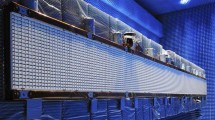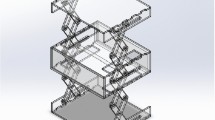Abstract
Due to the miniaturization of satellite components and advantages of low costs and short periods of development, nanosatellites are rapidly being developed to operate a wide variety of missions beyond only education purposes, such as Earth observation, relay communication, scientific objective, and even space exploration. As the role of nanosatellite grew, the reliability of nanosat’s thermal subsystem is also becoming very important to successfully carry it out. However, there is rare to find a research on thermal design reliability validation of 6U nanosatellite with increasingly large, diverse, and complex missions. Since reliability of satellite thermal design can be evaluated by on-orbit thermal analysis with the thermal mathematical model, more accurate analysis results can be obtained through more accurate thermal model. In addition, the thermal model can be improved by process of model correlation. The process begins with conducting thermal vacuum test (TVT) and is a flow that reduces thermal uncertainties by comparing the test results with analytical results. Nanosatellite systems are thermally closely connected within a limited space, so that thermal design cannot proceed conclusively for each subsystem and module. Therefore, it should always be done from a system perspective when thermal model of nanosatellite with multiple payloads is correlated especially. In this paper, we introduced a 6U nanosatellite of SNIPE (Small scale magNetospheric and Ionospheric Plasma Experiment) Mission that developing from KARI (Korea Aerospace Research Institute) and KASI (Korea Astronomy and Space Science Institute) for the near-Earth space environment scientific missions. For the successful mission operation, we conducted TVT for simulating space thermal vacuum environment to verify thermal design of thermal control system in the worst case. In addition, thermal model correlation of SNIPE nanosatellite was conducted through the TVT results with not only system level but each component and module. Based on the updated thermal model via the model correlation, we performed on-orbit thermal analysis to demonstrate the validity of thermal model and thermal design of the system level. As a result, we have confirmed that all components of the SNIPE nanosat satisfy the allowable temperature limit, which has correlated the thermal model and validated the thermal design successfully. The performed process can be applied to 6U or bigger nanosatellite for the objectives of practical missions or technology demonstrations that need the validity of thermal design and improvement of thermal model through the test and analysis. Therefore, this study is expected to contribute to the successful performance of the more complex and sophisticated nanosatellite missions to be developed.









Similar content being viewed by others
References
MIL-STD-1540E/SMC-TR-06-11 (2006) Test requirements for launch, upper-stage, and space vehicles, TR-2004(8583)-1 REV.A, The Aerospace Corporation, CA
Kang SJ, Oh HW (2016) On-orbit thermal design and validation of 1U standardized CubeSat of STEP Cube Lab. Int J Aerosp Eng 26:1–17. https://doi.org/10.1155/2016/4213189
James PM, Bret L, Thomas NW, Chloe D (2018) CubeSat on-orbit temperature comparison to thermal-balance-tuned-model predictions. J Thermophys Heat Transfer 32(1):237–255. https://doi.org/10.2514/1.T55169
Fennell TW Jr. (2020) Thermal management design of a 6U CubeSat with a high-power additive manufacturing payload using analytical modeling with experimental validation. Master Dissertation, Florida Institute of Technology, Melbourne, Florida
Song YB, Park SY, Lee SW (2021) Development of spacecraft formation flying system for SNIPE mission using four Nanosats. AIAA SciTech Forum. https://doi.org/10.2514/6.2021-0426
Timothy DP, Steven GR, Mark JW, David J, Brent AC, Douglas PB (2017) Thermal desktop user’s manual, 6th version, Cullimore and Ring Technologies, Inc., USA
Cullimore BA, Ring SG, Johnson DA (2017) SINDA/FLUINT user’s manual, 6th version, Cullimore and Ring Technologies, Inc., USA
Gilmore DG (2002) Spacecraft thermal control handbook, 2nd edn. The Aerospace Press
Karam R (1998) Satellite thermal control for system engineer. AIAA
Lee JJ, Kim HK, Hyun BS (2009) The correlation of satellite thermal mathematical model using results of thermal vacuum test on structure-thermal model. J Korean Soc Aeronaut Space Sci 37(9):916–922
Kim JS, Kim HK, Kim HD (2020) On-orbit thermal analysis for verification of thermal design of 6U nano-satellite with multiple payloads. J Korean Soc Aeronaut Space Sci 48(6):455–466
Acknowledgements
This research was supported by the “Development of Rendezvous/Docking Technology demonstration Nanosatellite based on AI” funded by the Korea Aerospace Research Institute (KARI) and “Development of Nanosatellite Bus for Near Earth Space Environment” funded by the Korea Astronomy and Space Science (KASI). We would like to thank KARI and KASI for their support.
Author information
Authors and Affiliations
Corresponding author
Additional information
Publisher's Note
Springer Nature remains neutral with regard to jurisdictional claims in published maps and institutional affiliations.
Rights and permissions
About this article
Cite this article
Kim, JS., Kim, HD. Thermal Model Correlation and Validation of a 6U Nanosatellite with Multiple Payloads. Int. J. Aeronaut. Space Sci. 23, 207–220 (2022). https://doi.org/10.1007/s42405-021-00409-4
Received:
Revised:
Accepted:
Published:
Issue Date:
DOI: https://doi.org/10.1007/s42405-021-00409-4




